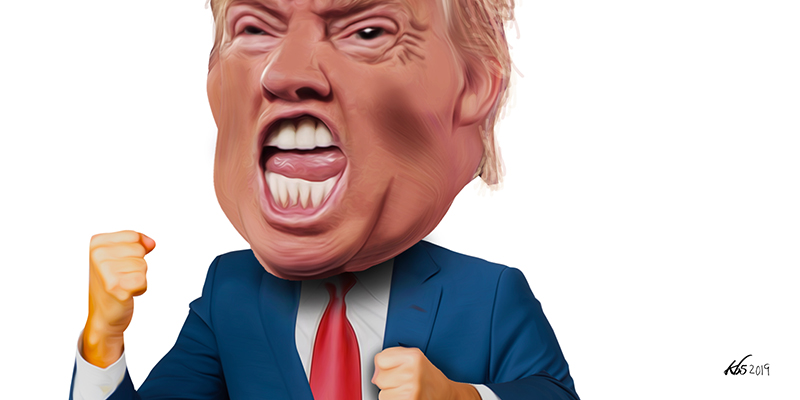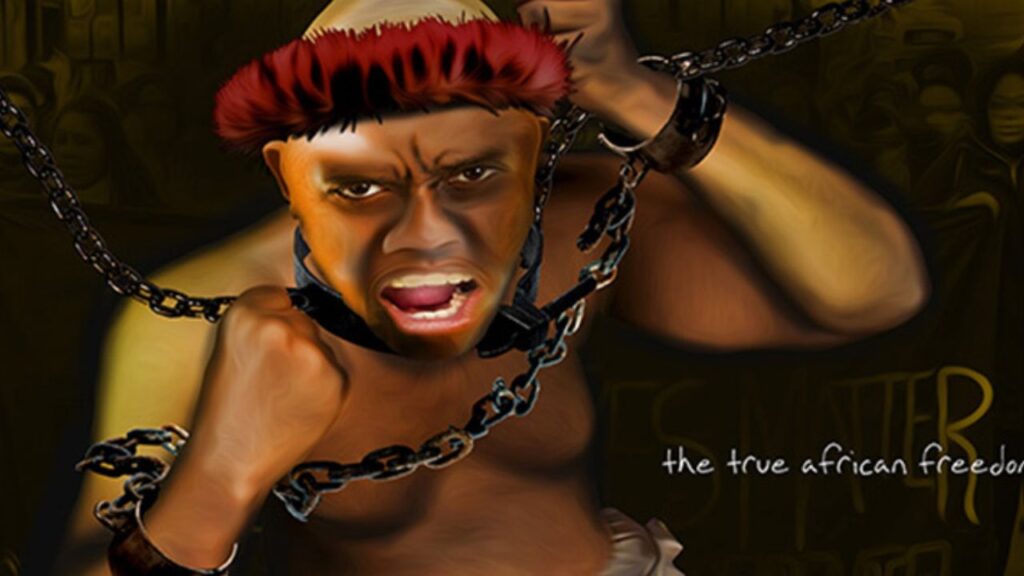The insurgency
Donald Trump barged into the political arena, and within a relatively short period of time, reconfigured the American political landscape. He won the 2016 election by a razor-thin margin in key electoral states and lost the 2020 election by only a slightly larger razor-thin margin. The election quantified the hypothesis that President Trump’s iconoclastic performance as head of state did little to alter the polarised perceptions dominating American politics.
Capturing the many voters disenchanted with both the Republican and the Democratic parties was the secret sauce powering Trump’s success. But instead of moving towards the middle once in power, Trump’s style of governance reinforced the gap. Both elections appear to have left the nation’s democratic equilibrium poised on a precarious fulcrum.
Security analyst John Robb was the first to analyse Donald Trump’s 2016 run at the presidency as an insurgency. Trump entered the primaries as an outsider and proceeded to dispense with the usual rules and protocols. His initial focus on the nation’s entrenched financial interests was coupled with his lack of clear positions on issues that would potentially divide his growing constituency. The assault on the mainstream media, which formed the second prong of his strategy, insulated him from the stream of criticism directed at his person and candidacy.
Self-funding his campaign further buffered the growing movement from the Republican Party establishment. Trump’s insurrection carried him into the White House, and he proceeded to trash the conventional sensibilities of the two-party system and the political campaign industry process.
Where many of us saw the Obama presidency as the end of a cycle dating back to the civil rights movement, as it turned out, it set in motion a new dialectic.
Blue Church versus Red Religion
At the turn of the millennium, Bill Clinton was at the forefront of academic analysts and policy pundits who used the Davos Economic Forum to promulgate the idea that the world’s financial architecture needed a structural makeover to address the challenges of the new century. Nothing happened. Structural inequality continued to facilitate elite control of the news media and political narratives. The West continued to invest in China, assuming that economic liberalisation will lead to political democratisation. The Forever War festered, draining financial resources that should have been reinvested at home.
The Obama presidency was not an anomaly in regard to these trends, and the Tea Party emerged as a direct response. Funded by the Koch Brothers’ political cartel, the Tea Party mobilised a large body of formerly politically inert citizens, including voters who had not responded to the activism of the religious right that contributed to the electoral success of the two Bush presidents.
Where many of us saw the Obama presidency as the end of a cycle dating back to the civil rights movement, as it turned out, it set in motion a new dialectic.
At its peak, public support for the movement was over 25 per cent of the electorate, with many more sympathetic towards its goals. The Tea Party and its congressional caucus became a party within a party. Although it could not enact its agenda on the national scale, the Tea Party drove many moderate Republicans out of public office. Due to the diversity of internal interests, its settled on a strategy that focused blame on big government, spearheaded by Grover Norquist’s radical anti-tax movement that had served as the driver of Newt Gringrich’s Contract with America during Bill Clinton’s presidency.
The Tea Party platform enjoyed the support of second-tier politicians like Sarah Palin, Michelle Bachmann, Ron Paul and other contenders for the Republican presidential nomination won by Mitt Romney in 2012. Trump gained favour with the movement through his anti-Obama antics, but otherwise was not seen as an active player. Four years later, pro-Tea Party candidates like Marco Rubio, Ted Cruz, and Lindsay Graham denigrated Donald Trump when he entered the race, only to change their colours when Trump’s scorched earth campaign reduced them to spectators.
Trump launched his candidacy by excoriating big donors, including political action committees empowered by the Citizens United legislation passed through the Koch brothers’ political machine. He derided his opponents for flocking to secret fundraising retreats hosted by the Koch Brothers’ cartel. The libertarian financiers opposed Trump in the beginning, but this divide was eventually bridged by his selection of Mike Pence for his running mate, a creation of the Koch political machine.
Assumptions about Trump’s poor prospects failed to factor in the larger forces contributing to Americans’ growing uncertainty and fear of the future. The domestic opportunity costs of Bush Junior’s foreign wars were exacerbated by the post-regime change failures of the Iraq and Afghanistan campaigns. The financial profligacy accompanying these interventions, Wall Street’s sub-prime mortgage pyramid scheme, and the state’s acquiescence to the lopsided relationship with China helped prepare the ground for the coming insurgency.
The state’s response to the post-9/11 terrorism threat created the biggest concentrations of financial resources since World War II, including the new Department for Homeland Security. The war chest became a magnet for bipartisan insider interests. Obama’s failure to reckon with the public’s disenchantment added to the accumulating problems accompanying the erosion of working class conditions in the nation’s heartland.
This allowed Trump’s campaign to portray the Democrats as the party of war while elevating Hillary Clinton to a symbol of the military-industrial complex’s self-interest. Under Steve Bannon’s direction, the Trump campaign effectively used propaganda to create an alternative narrative that bypassed the opposition’s criticism, while portraying them as supporters of policies responsible for America’s decline at home and abroad.
Trump’s campaign prioritised media-based tactics over the scripted playbook; in any case, mobilisation took precedence over the game of debating the movement’s political platform. The media blitzkrieg, refreshed with footage from Trump’s rock star performances at his rallies, condensed all of these elements into the Make America Great Again (MAGA) Kool-Aid. Hillary Clinton appeared to be winning most of the battles. But when the fog lifted, the same country that elected Barrack Obama to two terms had elected Donald Trump. No one knew how to best cope with the insurgency once he was in office.
The systems analyst, Jonathan Hall, portrayed the Trump insurgency on the campaign trail as highly effective desert guerrillas bent on turning everything into a desert. He described how the Trump campaign’s guerilla methods succeeded in creating confusion and disorder within the opposition camp. The insurgents were able to make the enemy over and under-react to activity that appeared to be ambiguous or misleading to an enemy aligned with the mainstream narrative.
In his 2017 Situational Assessment, Hall stated that the Trump insurgency was based on a new model of collective intelligence committed to disrupting the system on four fronts: the communications and media infrastructure; the economy of globalisation; the deep state; and the new culture war. He cast the latter as the battleground where the new Red Religion, which has emerged as the new counterculture, enjoys a strong advantage over the Blue Church, which has over the decades subverted many of the values of the American counterculture of the 1960s and 1970s. In the process, the Blue Church evolved into the same military-industrial and congressional political machine President Dwight Eisenhower had termed as the greatest threat to American democracy in 1958.
Trump actually crafted a line of attack similar to that to the original Blue Religion (my term) interpretation of American exceptionalism. It was relatively moderate but more focused compared to the political rhetoric of the Baby Boomers’ uprising. Unlike the moon-shot confidence of mid-century America driving the collective intelligence of the Blue Religion that emerged during that era, the Baby Boomers who responded to Trump’s message were reacting from a very different place.
Even before his election, analyses of the trauma many Americans were experiencing unpacked the deep-seated psychological factors contributing to the belief that the nation was primed for the entrance of a male hero, a champion who could bring order back to a chaotic world. These arguments demonstrate the human proclivity to “identify with the aggressor” during times of heightened uncertainty. This accounts for the movement’s more extreme contradictions, like the fact that the states most dependent on federal largesse provided the most passionate fans of the “drain the swamp” meme.
In his 2017 Situational Assessment, Hall stated that the Trump insurgency was based on a new model of collective intelligence committed to disrupting the system on four fronts: the communications and media infrastructure; the economy of globalisation; the deep state; and the new culture war.
During recent decades, the Ku Klux Klan, the John Birch Society, and other neo-Nazi organisations have transformed themselves from post-Reconstruction defenders of the white race to a rabidly anti-government network. Between 2008 and 2015, the Patriot Movement, a loose network of armed conspiracy theorists, had expanded from 149 groups to 874 in 2015, an increase of nearly 500 per cent.
Trump defied common sense by refusing to distance himself from the emboldened forces on the nation’s lunatic fringe. His dalliance with the KKK’s David Duke during the campaign and his failure to condemn the Charlottesville neo-Nazi marchers confirmed the outsized influence of Barrack Obama in the new head of state’s mind. His implicit acceptance of white supremacists became a show-stopper that worked to negate the import of the substantive policy initiatives he raised for potential Blue Religion converts.
The president’s excessive narcissism further complicated efforts to implement his MAGA mission.
Trump’s White House conundrum
Modern insurgencies are built by crafting a new narrative appealing to homeland religious and cultural values, and by exploiting their asymmetric advantages, like Trump’s use of Twitter to communicate directly with his supporters. They often require the rise of a charismatic leader to set them in motion.
Trump’s connection with his base attracted in turn the support of commentators like Fox TV star Tucker Carlson who, like Trump, originally grew his audience by attacking the corporate elite seen to control Washington. Carlson and other alt-right commentators walked the thin line of attacking the stereotyped Democratic Party enemy while avoiding direct criticism of the president’s failure to take on the economic elite and his controversial flirtations with dictators and traditional enemies abroad.
They seemed to be caught in an alt-right tractor beam that undermined their legitimacy among many in the wider audience when they did underscore important points. This worked well when it came to feeding the base, but it also deprived the Trump policy machine of the trusted feedback normal governments need to stay on course.
This was never going to be a normal government, but unlike the success of his disruptive methods on the campaign trail, Trump was not able to turn his populism into a clear advantage on the policy front. Gifted a growing economy by Barack Obama, the new captain steered the ship of the state straight into the heavy headwinds mainly of his own creation. Foreign policy offered the most promising area for gaining traction, but success proved elusive. Trump’s flirtations with Kim il Jong and Vladimir Putin distracted from his efforts to reconstruct trade relations with China.
The military advisors that Trump appointed during the transition provided the main constraint. One blogger described what happened:
Trump was hauled into a Pentagon basement “tank” and indoctrinated by the glittering four-star generals he admired since he was a kid. The session was part of the ongoing education of a president who arrived at the White House with no experience in the military or government and brought with him advisers deeply skeptical of what they labeled the “globalist” worldview. Trump was sold the establishment policies he originally despised. No alternative view was presented to him.
The author described the operation as “historically, the US military’s first successful counterinsurgency campaign”. The battle with the deep state ended in stalemate. Tearing up treaties proved to be easier than cutting new deals. The insurgency’s failure to overturn Obamacare provided an early marker of its limits.
Navigating the transition from rebellion to governing is the litmus test of successful insurgencies. The Trump regime struggled with this problem, starting with the backtracking when he named his key appointments. His transition team, for example, included the kind of corporate insiders he had assaulted during his campaign, including a Treasury Secretary recruited from Goldman Sachs. The eclectic crew Trump assembled opened up internal rifts in his White House.
Soon the president was fighting his own team. Staff walked the plank, others were keelhauled in public, and after months of ridicule, the Attorney General was dumped unceremoniously. Trump’s quest for unconditional loyalty led him to fall back on family and close friends like Rudy Giuliani, and to use events like the clash in Charlottesville to fire up the base. His first Chief of Staff, General Jim Mattis, was eased out after opposing Steve Bannon, who shortly afterwards was shown the door when he clashed with son-in-law, Jared Kushner. The churn became a consistent pattern.
Trump’s allies in the media remained in insurrection mode in the presence of the growing number of setbacks and self-inflicted blunders. Commentators who excelled in turning obscure stories and isolated incidents into larger narratives sidestepped fact-driven analysis of complex issues, and avoided constructive criticism of the Trump government in general.
Blue Church media critics fought back by retreating into the role of the moral resistance who evaluated many of Trump’s policies as an extension of his unsavoury persona. Congressional Democrats contributed to the quagmire by equating Russian maskirovka with collusion, then launching their doomed-to-fail impeachment gambit. Although the mid-term elections provided the Democrats with a much-needed respite, they were not able to leverage their momentum into a more effective counterinsurgency strategy.
Soon the president was fighting his own team. Staff walked the plank, others were keelhauled in public, and after months of ridicule, the Attorney General was dumped unceremoniously.
The outcome was four years of trench warfare. Both sides slogged it out, making small inroads only to relinquish their gains on one front by overplaying their hand on another. Instead of using his China policy to unite the nation behind his government’s most critical initiative, Trump continued to antagonise potential allies on the other side of the aisle. Progressive activists reciprocated by carelessly using the Defund the Police slogan to brand their push for reforms while cities were burning.
Then the pandemic came. Trench warfare morphed from metaphor into real-life strategy as cities and states locked down to defend against the corona virus. Would the civilian Donald Trump have adopted the same anti-science position the Presidential Trump championed? As it turned out, what could have been seized as the final opportunity to transform his insurgency into a war against a common enemy ended up being the battleground for its last stand in the White House.
The aftermath
Joseph Biden’s narrow victory has set the stage for another four years of the Obama-Trump dialectical status quo. The Republicans lost the White House but made gains in most other areas, including the state legislatures that will be in charge of the next phase of redistricting. As many commentators have pointed out, there is also the matter of the 73 million Americans who voted for Trump.
The new government, including many figures from former President Obama’s administration, is taking shape at a time when widespread allegations of electoral fraud have exposed the desperation of the insurgency’s Trumped-up narratives. If the Democrats post-2016 strategy reflected serious errors of judgment and the lack of a coherent strategy, Trump’s post-electoral Twitter offensive and the legal response backing it has been a comedy of errors, highlighting the kind of double-speak semantics Republican spin doctors have resorted to since the Reagan era.
In one Pennsylvania case where Trump’s team tried to stop ballot counting, the lawyers were forced to admit, contrary to false claims that no Republican observers were present, that a “nonzero number of Republican observers” were allowed to witness the ballot counting. Another federal judge described the campaign’s legal arguments as “inadmissible hearsay within hearsay”. One legal expert cited in the same report observed that “the lawsuits are so groundless that the lawyers are more likely to be sanctioned for pursuing them than to succeed in court”.
Trump’s unpredictable and flawed leadership compromised the insurgency’s capacity to parlay its incumbency into a popular vote majority. The endgame is emblematic of how the insurgency degenerated into an exercise in disruption that has subjected American democracy to its most severe stress test in decades. But the current state of polarity should not obscure the complex dynamics driving American society.
In a 2017 article, I viewed the Trump insurgency as a useful development. No matter what we may think of Trump the person, he has succeeded in modifying the topography of the political landscape while identifying many of the issues that will continue to be contested during the next phase of globalisation. More importantly, the insurgency has brought into the open the socio-economic dynamics, tactics, and political actors driving the Red Religion.
In the meantime, one survey found that Republican mistrust of the electoral system zoomed from 35 per cent to 75 per cent following the election. This spike, despite this election being the most transparent and invigilated election in the nation’s history, shows that what people say is often distinct from what they really think and how they behave.
Ingenuous responses to the polls is another consequence of the insurgency. Although these numbers will likely prove to be transient, they are providing the platform for the next stage of Donald Trump’s political career. This raises two questions: what proportion of the 73 million Trump voters are hard core insurgents committed to the long haul; and how will Biden’s government influence those who are not?
The Trump government used its control of the White House and the Senate to cement the conservative majority in the Supreme Court, but this is balanced by the demographics favouring progressive forces over the coming decades. The COVID-19 pandemic and the government relief packages it triggered are placing the long-standing defund-the-state anti-tax movement in its real world context. States that cut budgets in line with the Norquist agenda are suffering the effects of crippled education systems and public services. One Koch brother died, and his survivor has reportedly expressed misgivings about their machine’s socially polarising politics.
These developments are, however, complicated by Trump’s role as an agent of radicalisation.
From insurgency to jihad?
Traditional insurgencies are all-or-nothing struggles in which only one side can prevail in the end. Modern jihads, in contrast, are a more networked variation on guerilla warfare that tend to increase their asymmetric advantages when they do not occupy the terrain hosting the populations involved in the contest.
For the past year I have been following a large pro-Trump Twitter group curated by several security analysts. Post-election posts have ranged from legal and geopolitical arguments to nutcase Release the Kraken conspiracy theories. Many tweets in support of Trump since the election continue to elicit five-figure approvals, and sometimes more in the case of prominent Republican supporters. But the likes and retweets for posts calling for extreme responses decline to between three and low four figures, and support for those calling for Boogaloo-style violence rarely total more than two digits.
Donald Trump is not going away. But the defection of some of his key allies in the corridors of power and the distancing of some of his most important media influencers will make it difficult to for him to sustain the political euphoria he fed on. Such defections often signal an insurgency’s decline.
The new culture war will grind on, identity politics are likely here to stay, and the Blue Church may be living on borrowed time. The long-overdue removal of civil war statuary, the Confederate flag ban, and the large multiracial protests against police impunity are examples of Blue Religion maneouvers outflanking the Red Religion’s embrace of indefensible positions.
Donald Trump is not going away. But the defection of some of his key allies in the corridors of power and the distancing of some of his most important media influencers will make it difficult to for him to sustain the political euphoria he fed on. Such defections often signal an insurgency’s decline.
These factors favour the Trump insurgency’s shift into jihadi mode. Donald Trump appeared to bristle under the protocols that came with being head of state. A revengeful Trump released from these constraints could prove to be a hard to control free agent. Just as most of the victims of Islamist extremism are Muslim, this augurs poorly for the Republican Party. Trump has already targeted several Republican state governors, and the party elders are concerned that the carnage will compromise Republican prospects in the next mid-term elections.
The prospects for Trump’s second act in the political arena now appear less than sanguine, especially should the Democratic mount an effective counterinsurgency strategy. There is no shortage of ambitious camp followers hoping to assume the former president’s mantle. Then there is the karmic price to be paid for his antics in public office. Anything could happen, but the same tide that floated his boat is now going out.
Without Donald Trump, the next phase of the insurgency is likely to involve reversion to the low-intensity conflict that was there before his rise, or, to use the more conventional term, a return to politics as usual.








